Port Royal Border Ware Assemblage
Tripod Pipkin Base (PR89 683, PR90 944-2)
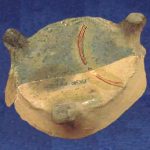 This artifact has been cross-mended from two sherds, each found in association with the Building 4/5 complex. Post-depositional factors have resulted in the two sherds exhibiting variations in their respective glaze hues. Both sherds are interior-glazed white ware. PR89 683 exhibits a yellow (Munsell 10YR 6/6) glaze hue, while PR90 944-2 exhibits a green (5Y 5/4) glaze hue. There is no exterior glaze in either case, with the exception of some green (5Y 5/6) glaze associated with a 2-mm thick fabric scar, a result of adhesion during firing. Interestingly, this sample exhibits a white clay matrix, while the scar is clearly from a red Border ware vessel. Fire markings are evident and clearly point to the heating and/or cooking function of the vessel . The vessel walls of Sample 1 measure 4 mm thick.
This artifact has been cross-mended from two sherds, each found in association with the Building 4/5 complex. Post-depositional factors have resulted in the two sherds exhibiting variations in their respective glaze hues. Both sherds are interior-glazed white ware. PR89 683 exhibits a yellow (Munsell 10YR 6/6) glaze hue, while PR90 944-2 exhibits a green (5Y 5/4) glaze hue. There is no exterior glaze in either case, with the exception of some green (5Y 5/6) glaze associated with a 2-mm thick fabric scar, a result of adhesion during firing. Interestingly, this sample exhibits a white clay matrix, while the scar is clearly from a red Border ware vessel. Fire markings are evident and clearly point to the heating and/or cooking function of the vessel . The vessel walls of Sample 1 measure 4 mm thick.
Tripod Pipkin (?) Rim/Body (PR90 944-2, PR90 947-2 [x2], PR89 670-2)
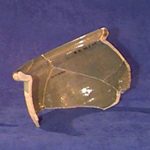 This artifact has been cross-mended from four sherds, each found in association with the Building 4/5 complex. This artifact is interior-glazed white Border ware. The glaze hue tends toward green (5Y 5/4). The body thickness measures 4 mm, while the rim thickness measures 7 mm. The design of the rim is to accommodate a vessel lid by means of an interior step. While Samples 1 and 2 do not cross-mend, both were found in the same location; their glaze, fabric, and form all suggest that they are part of the same vessel.
This artifact has been cross-mended from four sherds, each found in association with the Building 4/5 complex. This artifact is interior-glazed white Border ware. The glaze hue tends toward green (5Y 5/4). The body thickness measures 4 mm, while the rim thickness measures 7 mm. The design of the rim is to accommodate a vessel lid by means of an interior step. While Samples 1 and 2 do not cross-mend, both were found in the same location; their glaze, fabric, and form all suggest that they are part of the same vessel.
Mug (?)/ Storage Pot (PR90 904-44, PR90 904-14 [x2])
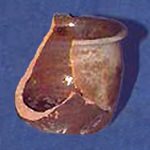 This vessel was cross-mended from three fragments found in Yard 5, Building 5. This artifact is red Border ware with interior and exterior glaze. The interior glaze is likely clear, allowing much of the clay’s color to dominate the hue. The exterior glaze appears olive (10YR 4/4), although this is likely reflective of a thicker application of the clear glaze. This sample is a probable mug, although of a form unrecorded in existing typologies. The red clay matrix is, however, consistent with the corpus of known Border wares, as is the glaze type and elements of manufacture present (e.g, knife trimming on the base, a clockwise wheel spiral on the interior surface). Patches of gray are likely indicative of smoke present in the kiln at the time of firing. The vessel’s walls measure 6 mm thick.
This vessel was cross-mended from three fragments found in Yard 5, Building 5. This artifact is red Border ware with interior and exterior glaze. The interior glaze is likely clear, allowing much of the clay’s color to dominate the hue. The exterior glaze appears olive (10YR 4/4), although this is likely reflective of a thicker application of the clear glaze. This sample is a probable mug, although of a form unrecorded in existing typologies. The red clay matrix is, however, consistent with the corpus of known Border wares, as is the glaze type and elements of manufacture present (e.g, knife trimming on the base, a clockwise wheel spiral on the interior surface). Patches of gray are likely indicative of smoke present in the kiln at the time of firing. The vessel’s walls measure 6 mm thick.
Chamber Pot (PR90 469-6)
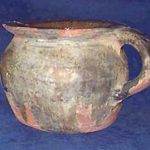 This vessel was recovered from the Building 4/5 complex. It accords with Pearce’s (1992) Type 2 form (see above). It is of the red Border ware type, with green (2.5Y 4/4) glaze evident on both surfaces. However, the exterior glaze is incomplete and haphazard, with flow running down the sides and covering portions of the base (the direction of the glaze run suggests upright firing). The vessel displays a flat lid and a broad horizontal handle, which is thumb-impressed at the lower terminal.
This vessel was recovered from the Building 4/5 complex. It accords with Pearce’s (1992) Type 2 form (see above). It is of the red Border ware type, with green (2.5Y 4/4) glaze evident on both surfaces. However, the exterior glaze is incomplete and haphazard, with flow running down the sides and covering portions of the base (the direction of the glaze run suggests upright firing). The vessel displays a flat lid and a broad horizontal handle, which is thumb-impressed at the lower terminal.
Porringer (PR89 747-5)
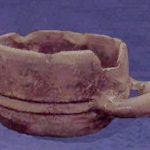 This vessel exhibits classic porringer styling, with a horizontal handle and horizontal decorative trimming around its circumference. The vessel is likely brown (10YR 3/4) glazed on a red clay. Both the interior and exterior surfaces are glazed. Patches of gray (2.5YR 4/0) are present on the interior and exterior and do not appear to be a result of either contamination during firing or from use in cooking/heating. The body thickness measures approximately 6 mm; the handle is 14 mm thick. The vessel’s diameter measures 97 mm. It is 57 mm tall.
This vessel exhibits classic porringer styling, with a horizontal handle and horizontal decorative trimming around its circumference. The vessel is likely brown (10YR 3/4) glazed on a red clay. Both the interior and exterior surfaces are glazed. Patches of gray (2.5YR 4/0) are present on the interior and exterior and do not appear to be a result of either contamination during firing or from use in cooking/heating. The body thickness measures approximately 6 mm; the handle is 14 mm thick. The vessel’s diameter measures 97 mm. It is 57 mm tall.
Porringer (PR87 423-3)
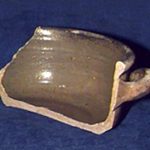
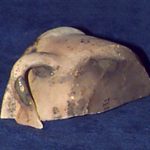 This vessel, found in likely association with Building 4, is white Border ware with olive (5Y 4/3) interior glaze. It is here shown from two angles. The body measures 4 mm in thickness, while the base, which is noticeable kicked, is 6 mm thick. The exterior ridge immediately below the lip is finger impressed.
This vessel, found in likely association with Building 4, is white Border ware with olive (5Y 4/3) interior glaze. It is here shown from two angles. The body measures 4 mm in thickness, while the base, which is noticeable kicked, is 6 mm thick. The exterior ridge immediately below the lip is finger impressed.
The vessel’s handle is horizontal and upturned with one end luted (pressed) to the body and the other smoothed. Small patches of glaze exist on the exterior, along with a possible kiln scar from contact with another vessel during the firing process. The patches of glaze on the exterior range in hue from 10YR 8/2 to 7.5YR 7/6. The exterior is fire-stained in several places, which suggests a contextual association with a hearth/cooking fire.
Unknown Vessel (PR89 897-2)
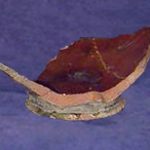 This vessel, found near the hearth area of Building 4 (with possible Building 5 association), may be out of the stylistic demarcation of know Border wares in existing typologies. This vessel exhibits red (2.5YR 5/6) paste and either brown (2.5YR 3/4) or heavy clear glaze on the interior only. Patches of green (5GY 4/4) glaze found on the exterior are not associated with this vessel but rather with an extant kiln scar. The vessel’s base is caked with ash. It is possible that the vessel was slightly ovate, although this is difficult to substantiate given the minimal level of completeness. Its burned clay matrix suggests that it was, perhaps, broken and burned prior to catastrophic burial. The base is wheel-impressed rather than kicked.
This vessel, found near the hearth area of Building 4 (with possible Building 5 association), may be out of the stylistic demarcation of know Border wares in existing typologies. This vessel exhibits red (2.5YR 5/6) paste and either brown (2.5YR 3/4) or heavy clear glaze on the interior only. Patches of green (5GY 4/4) glaze found on the exterior are not associated with this vessel but rather with an extant kiln scar. The vessel’s base is caked with ash. It is possible that the vessel was slightly ovate, although this is difficult to substantiate given the minimal level of completeness. Its burned clay matrix suggests that it was, perhaps, broken and burned prior to catastrophic burial. The base is wheel-impressed rather than kicked.
Chamber Pot (PR90 908-6)
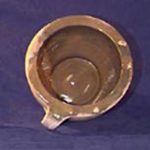
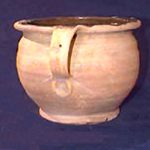 The sample (two views shown) appears to be a hybrid between Pearce’s (1992) Type 1 and Type 2 chamber pot styles. The vessel exhibits Type 1 styling in its overall evenly rounded form, with the glaze exclusively coating the vessel’s interior. Type 2 styling, however, is shown in the flat, broad rim, as well as the vessel’s relatively squat profile. The vessel has one flat, broad handle attached at the rim and mid point of the body. The handle’s lower terminal exhibits a thumb-impressed decorative mark. A thumb-impressed groove beneath the rim is also evident. This is a decorative effect common in chamber pot typologies. Various kiln scars are evident on the vessel’s base, lid, and interior surfaces. Scars on the base are associated with small patches of green (5Y 5/4) glaze. The existence of interior scars provides evidence that during firing, smaller vessels were placed within larger ones in an effort to increase kiln productivity. This vessel was associated with the closed closet/privy area of Yard 5, Building 5.
The sample (two views shown) appears to be a hybrid between Pearce’s (1992) Type 1 and Type 2 chamber pot styles. The vessel exhibits Type 1 styling in its overall evenly rounded form, with the glaze exclusively coating the vessel’s interior. Type 2 styling, however, is shown in the flat, broad rim, as well as the vessel’s relatively squat profile. The vessel has one flat, broad handle attached at the rim and mid point of the body. The handle’s lower terminal exhibits a thumb-impressed decorative mark. A thumb-impressed groove beneath the rim is also evident. This is a decorative effect common in chamber pot typologies. Various kiln scars are evident on the vessel’s base, lid, and interior surfaces. Scars on the base are associated with small patches of green (5Y 5/4) glaze. The existence of interior scars provides evidence that during firing, smaller vessels were placed within larger ones in an effort to increase kiln productivity. This vessel was associated with the closed closet/privy area of Yard 5, Building 5.
